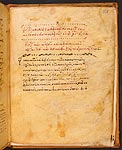Tetraevangelion.
1144. Constantinople. Scribe: Monk John, the Logothete of the Grand (Constantinople) Church
F (275 ű 215). I-II +III-IV+331+II leaves. The beggining is missing.
Parchment. Ink.
It is written in a minuscule hand.
The scribe's inscription on folio 331r says that he completed the manuscript on 23 February in 1114, during the reign of Manuel I Komnenos. There are notices about a comparison of the text "with ancient Jerusalem copies, kept on the Holy Mountain", counting verses and chapters (folios 66v, 247v and others). The end of each Gospel is followed by the Archbishop Porfiry Uspensky's inscription, stating that he explored the manuscript in Saint Petersburg, at the St. Alexander Nevsky Monastery in 1863. The codex is remarkable for the peculiar style of its auxiliary tool. The manuscript does not contain headings of Gospels, numbers and titles of chapters are written on the upper margins. The outer margins have references to the Eusebian Canons, which are not summarized in Canon Tables at the start of the Gospels, as usually. The canons are indicated in the lower margins on all leaves of the manuscipt. At that, the names of the Evangelists are enclosed in small circles of regular shape. Special marks on the margins, like inverted commas, indicate citations from the Old Testament.
In 1883 the manuscript came into the Imperial Public Library with the material gathered by Archbishop Porfiry Uspensky.
Shelfmark: –ÕŃ. √ūŚų. 222.





